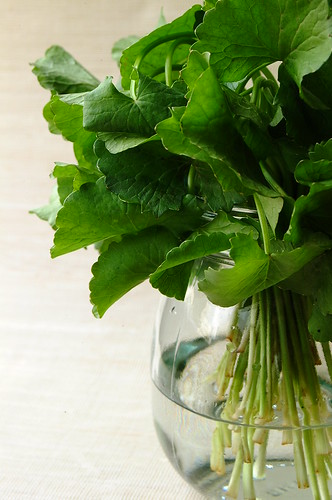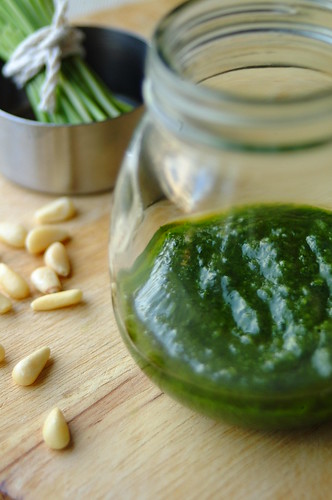
Bron Marshall invites all of us to take a walk on the wild side, food-wise, with Wild Food, an exciting new food blogging event. I would have wanted to join the first round but I had difficulty luring an edible reptile into my kitchen, so I waited to see what the second round would bring. Well, the time has come and the theme is…Wild Weeds!
Hah! Weeds, or herbs, are much easier to catch then reptiles so I put on my hunting cap and went out into the wild world to see if I could capture some. Ok, truth be told I went to our city’s weekend market and bought some from the very nice man at my favorite herb stall. I thought of descending on his stall in my Lara Croft Herb-Raider outfit, but I didn’t want to scare off his other customers.
The herb I’m using for this entry, although I am not quite sure exactly how wild it is, is Gotu Kola, also known as: Asiatic Pennywort, Antanan, Pegaga, Kula kud, Brahmi (in Sanskrit, meaning the energy of Brahma), Creeping Saxifrage, and (my favorite) Blood Stopping Grass. It grows in wet places like marshlands, swamps, and paddy fields. That sounds pretty wild right?
Now, don’t think I went out and got some ordinary creeping swamp-dweller. Gotu Kola has been used in Ayurvedic and Chinese medicine for hundreds of years! It is known to improve memory (it’s a favorite of elephants!) and prevent ageing. It has also been used in treating leprosy and tuberculosis, as well as relieving the pain of rheumatism and arthritis. It has been called many things through the ages, such as: brain food, memory herb, the finest of all herb tonics, a pharmacy in one herb, and the elixir of life. In ancient China, it was a main ingredient in a medicinal blend called “fo ti tieng”, a mixture that was called the fountain of youth.
And to think the first time I discovered it (visiting a farm in Tagaytay) I just thought it was a cute salad green.
Gotu Kola is used in Sri Lankan cuisine, most often as a condiment to rice and curry. It can also be brewed into a tea. I have been tossing it into my salad all this time, but for this event I decided to do something different and made it into a pesto. 
Gotu Kola Pesto
- 1/2 cup Gotu Kola leaves, remove all stems
- 1/2 clove garlic (unless you like it really garlicky like I do, in which case use one whole clove)
- 1/4 cup freshly grated parmesan cheese
- 1 heaping tablespoon pine nuts
- 1/8 cup olive oil
– Place Gotu Kola, garlic, parmesan, and pine nuts the tall container that comes with your immersion blender, and process while slowly adding in the oil. Alternately, you can do this in a food processor.
– This will make enough pesto for one use, or two if you really want to stretch it.
I hardly ever make big batches of pesto nowadays because it’s not really C’s thing, and I can’t be counted on to finish a bottle by myself before it turns iffy. It’s better to have pesto fresh anyways. I had no idea what to expect of this Gotu Kola pesto. The leaves themselves are a bit sour with a slightly bitter kick, but I have tasted young leaves which are actually sweet in the beginning before ending in a spicy note. That’s why it’s great to mix in salads as it really adds dimension and character. The pesto was surprisingly delicate in flavor with the herbs characteristic astringency nicely muted. I can imagine this would make a great pasta dish…maybe with some peas. Or maybe toasted on some pan de sal (popular local bun) with some kesong puti (local fresh white cheese) Mmm… You can learn more about Gotu Kola here, here, here, and here.
A legendary saying about Gotu Kola goes like this: “Two leaves a day, keeps old age away”. I used half a cup of leaves here (a lot more than just two leaves). That’s one serving, maybe two. You do the math. Wild.
Hi Anonymous! Since I don't live in the US I really don't know where you could find it over there. Sorry, wish I could be more help!
A very well written blog indeed, additionally, the blog is so concise and interesting. I am a big fan of herbs and I drink Gotu Kola as a tea on a regular basis (and yes it is tasteless).
I am very glad that I come across your blog and I would definitely try this pesto soon. Just a query if I may, do you know of a good Filipino herb book? Would be grateful if you can recommend one at least (the more the better though).
All the best!
Hi Francis! Thanks for visiting! Wish I could help you out but I don't know of any Filipino herb book…if you find one let me know!
Hello there! I actually grow Gotu Kola plants in my backyard.
I've been meaning to try them but I heard they taste awful. Your description (sour & bitter) sort of confirms it.
Maybe for your next pesto experimentation, you can just add a tinge of Gotu Kola, but still have Sweet Basil as your primary leaf.
Hi Chris! I wouldn't say they taste awful 🙂 In fact, I do think they add an interesting note in a green salad…and it was just fine in this pesto all by itself 🙂
Hi ChichaJo! I'll buzz you if I ever strike up the courage to take a bite on my Gotu Kola. 😉
Hello Chichajo,
Gotu Kola is known locally in the Philippines as takip-kuhol and it is used widely in Vietnam as a cure or preventative for/of rheumatic pains. You can make a really refreshing herbal-vegetal tasting beverage by taking a handful of plucked and washed leaves and blitzing it in a blender with cracked ice and simple syrup. After blitzing, strain. An awesome restorative on hot days.
Kind regards,
Jelo
Hi Jelo! Thanks for all the good information on gotu kola! 🙂 That drink does sound good right about now!